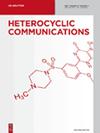苯并二恶唑衍生物作为潜在抗癌和抗氧化剂的合成及生物学评价
IF 1.5
3区 化学
Q3 CHEMISTRY, ORGANIC
引用次数: 21
摘要
摘要:本文合成了一系列苯二唑类化合物,并对其对宫颈癌(Hela)、结直肠癌(Caco-2)和肝癌(Hep3B)的细胞毒活性进行了评价。化合物5a、5b、6a、6b、7a和7b的抗癌活性非常弱或可以忽略,IC50为3.94 ~ 9.12 mM。相反,含有甲酰胺的化合物2a和2b具有抗癌活性。与未处理细胞的2519.17 ng/ml相比,2a和2b分别使α-胎蛋白(α-FP)的Hep3B分泌量降低至1625.8 ng/ml和2340 ng/ml。结果还表明,化合物2a对Hep3B癌细胞具有较强的抗癌活性。此外,在细胞周期分析中,化合物2a诱导G2-M期阻滞的值为8.07%,与阿霉素的活性(7.4%)非常接近。这些结果表明,化合物2a具有较强的抗肿瘤活性。与强力抗氧化剂Trolox (IC50 = 7.72 μM)相比,苯二氮卓类衍生物(7a和7b)的IC50分别为39.85和79.95 μM,表现出中等的抗氧化活性。本文章由计算机程序翻译,如有差异,请以英文原文为准。
Synthesis and Biological Evaluation of Benzodioxole Derivatives as Potential Anticancer and Antioxidant agents
Abstract a series of benzodioxole compounds were synthesized and evaluated for their cytotoxic activity against cervical (Hela), colorectal (Caco-2), and liver (Hep3B) cancer cell lines. Compounds 5a, 5b, 6a, 6b, 7a and 7b showed very weak or negligible anticancer activity with IC50 3.94-9.12 mM. On the contrary, carboxamide containing compounds 2a and 2b showed anticancer activity. Both 2a and 2b reduced Hep3B secretions of α-fetoprotein (α-FP) to 1625.8 ng/ml and 2340 ng/ml, respectively, compared to 2519.17 ng/ml in untreated cells. The results also showed that compound 2a has potent anticancer activity against Hep3B cancer cell line. Furthermore, in cell cycle analysis, compound 2a induced arrest in the G2-M phase in value of 8.07% that was very close to the activity of doxorubicin (7.4%). These results indicate that compound 2a has a potent and promising antitumor activity. However, benzodiazepine derivatives (7a and 7b) showed moderate antioxidant activity with IC50 values of 39.85 and 79.95 μM, respectively compared with the potent antioxidant agent Trolox (IC50 = 7.72 μM).
求助全文
通过发布文献求助,成功后即可免费获取论文全文。
去求助
来源期刊

Heterocyclic Communications
化学-有机化学
CiteScore
3.80
自引率
4.30%
发文量
13
审稿时长
1.4 months
期刊介绍:
Heterocyclic Communications (HC) is a bimonthly, peer-reviewed journal publishing preliminary communications, research articles, and reviews on significant developments in all phases of heterocyclic chemistry, including general synthesis, natural products, computational analysis, considerable biological activity and inorganic ring systems. Clear presentation of experimental and computational data is strongly emphasized. Heterocyclic chemistry is a rapidly growing field. By some estimates original research papers in heterocyclic chemistry have increased to more than 60% of the current organic chemistry literature published. This explosive growth is even greater when considering heterocyclic research published in materials science, physical, biophysical, analytical, bioorganic, pharmaceutical, medicinal and natural products journals. There is a need, therefore, for a journal dedicated explicitly to heterocyclic chemistry and the properties of heterocyclic compounds.
 求助内容:
求助内容: 应助结果提醒方式:
应助结果提醒方式:


